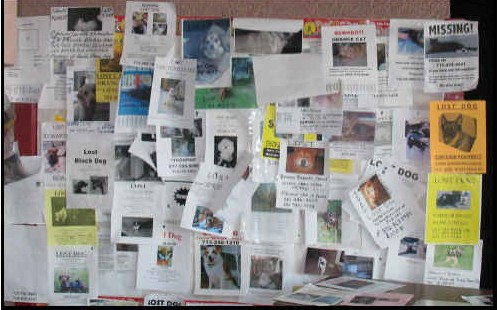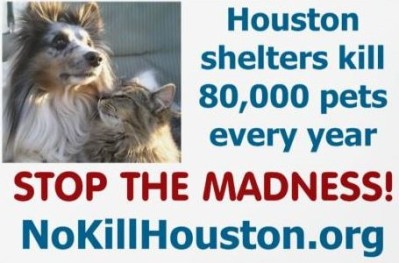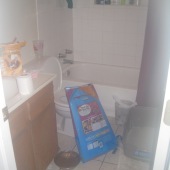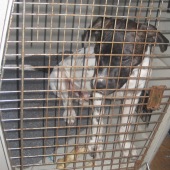Houston, TX – There is an odd myth among a lot of people in the south that communities in more northern states do not have kill shelters. Some southerners have said that communities up north are literally begging for more dogs and cats and that their shelters have empty cages because there is such a shortage of companion animals there.
I’ve heard many stories about southern rescuers transporting animals up north to what they believe is “mecca”; the magical northern state where no shelter pets are killed. Unfortunately, this belief is fiction. If it were true, No Kill advocacy groups like No Kill Colorado, No Kill Wisconsin, No Kill New York, No Kill New Hampshire, No Kill New Jersey, No Kill Ohio and Animal Ark in Minnesota, would not exist. There would be no need. But they do exist because there are kill shelters in northern states who are killing shelter pets just like in the south. Those northern kill shelters are killing for the exact same reasons that kill shelters in the south are killing….. shelter management refuses to implement the No Kill model of sheltering.
Recently, I was contacted by Davyd Smith, who runs No Kill Colorado. Just like in the south, they are working to end shelter killing in Colorado. Davyd was concerned because he had heard that a Houston group was shipping hundreds of animals to CO. He was also concerned because he heard that Houston city council was considering giving this group more than $400,000 to ship thousands more BARC animals to their communities while they are fighting their own battles to end shelter killing.
It turns out Davyd was right. I later received BARC’s proposed budget confirming that BARC was asking for $415,000 to pay Rescued Pets Movement (RPM) to transport BARC animals to CO.
Obviously, it is a good thing when animals are pulled to safety from BARC, which is Houston’s pound that killed/lost 12,500+ shelter pets last year. Over the years, I’ve pulled a lot of animals out of BARC either by adoption or by fostering and believe me, I understand the desperation of rescuers who stand in front of perfectly wonderful, adoptable animals that are slated for death at BARC the next day if no one pulls them. I’ve looked into those innocent faces and I understand the sadness and frustration of not being able to save them all because Houston’s pound in run by management that absolutely refuses to implement the No Kill model of sheltering that has been proven to save lives.
And, I’ve seen the pictures with all the cute shelter pets being loaded onto vans headed for that promised “mecca”. I understand how some rescuers would be desperate to believe in that mecca. But, we cannot look at transports in a vacuum. We cannot turn a blind eye to what is happening at the other end of the transports. To do so would be, at the very least, unethical.
If we ship hundreds or thousands of shelter pets to other communities with kill shelters, that means that rescuers in those communities will not be able to pull animals off the kill lists. Therefore, animals in those kill shelters are killed.
Can we really call this saving lives? Isn’t this just exchanging one life for another?
Do Houstonians have the right to “dump” the problems of our high kill shelters on other communities who are also struggling to save lives?
Is it ethical to make Houston’s kill shelter’s numbers look better at the expense of animals in another community?
I do not believe it is ethical, nor is it a viable humane solution.
It is not fair to the rescuers in Colorado who now have to scramble even harder to save Colorado shelter pets lives because some of their foster parents and rescue groups are loaded up with Houston pets. It is not fair to the shelter pets in Colorado who are on death row but will not be pulled to safety by a rescue group or foster parent because those rescuers are full with Houston pets.
Mike Fry, the director of Animal Ark, wrote about the problems associated with the transport of shelter pets from the south to kill shelters in his community and other northern states. He wrote:
“A logical person would be inclined to ask, “If the transports result in no net life-saving (and they don’t), then why do they happen?” It was a question I was able to ask the director at a southern shelter that regularly ships dogs to New York.
The shelter in question was the Huntsville, Alabama animal control facility. The shelter’s director, Dr. Karen Sheppard, has maintained a miserable save rate. She is currently saving only about 25% of the cats for which she is responsible, for example.
During a recent phone conversation with Sheppard, we talked about these transports. Almost immediately, she acknowledged that the New York shelter system was very broken, resulting in a lot of needless killing. When she said this, I immediately asked her, “If you know about all the killing going on in New York, why are you shipping so many animals there?”
Sheppard laughed and simply exclaimed, “You KNOW [emphasis her’s] why we are doing it!”
In fact, I DO know why she, and others like her, are shipping animals to communities that are still killing large numbers of their own animals: It makes all of the shelters look like they are doing better than they actually are. Sheppard herself has recently been credited with “improving” the “save rate” for dogs to nearly 50%. However, a careful look at the statistics shows that nearly all of the “improvement” is the result of the transport of dogs to New York.
This seems to be a very controversial and heatedly debated topic here. In fact, I posted questions on RPM’s Facebook page asking them if they knew that communities that they are transporting thousands of animals to are NOT No Kill communities meaning these transports could very well cause CO shelter pets to die. I even posted some of the Colorado statistics. No answer was forthcoming from RPM, but some RPM supporters immediately jumped in and called me a liar.
There was no attempt to even look at facts; just the immediate spewing of lies and vulgarity.

I have records from Colorado that rescue groups and shelters are required to file with the state. It clearly shows that the communities where RPM is shipping BARC animals DO have kill shelters that are killing shelter pets. Sometimes, more than one kill shelter. The numbers are there. Yes, they have lower kill rates than BARC, but they are still killing adoptable shelter pets. But, apparently RPM and supporters, do not want to look at facts about the cities where they have sent over 2,600 animals, and the consequences they can cause.
To add to my concerns of Colorado shelter pets being killed because of these transports, additional very troubling information was forwarded to me. I received copies of a Complaint filed against one of the rescue groups in Colorado (New Hope Rescue) where RPM shipped BARC pets. The investigation of New Hope includes pictures of animals being kept in absolutely filthy conditions. The house where many animals were roaming free, shows feces and urine all over the house; not just in cages as BARC’s director, Greg Damianoff, told a reporter; it is EVERYWHERE. It looks like a hoarding house. (The Complaint and investigative reports are linked at the bottom of this blog and pictures from the investigations are posted below).
The investigation report shows multiple visits to the New Hope house with multiple problems noted on multiple dates. The report says that the ammonia level in one room was so high that the animals in the room were confiscated and taken to animal control…..a KILL shelter in Colorado Springs. These were animals shipped to New Hope by RPM. So, BARC animals were pulled from one kill shelter and ended up in another kill shelter in another state. Look at the pictures, and read the Complaint and investigation report. Ask yourself if you would be concerned to know that BARC shelter pets were being shipped there. Ask yourself if you would be concerned when the photos and investigation are shown to RPM and BARC director, Greg Damianoff but are simply dismissed as “just mess in a puppy cage”. Ask yourself if you think this whole situation is a good solution.
One of RPM’s founders, Laura Carlock, recently told a reporter, that she personally visited all of the locations where they are transporting BARC animals. RPM also issued a statement saying “We have VERY close relationships with the groups in Colorado with whom we work. Very close. We correspond with them no less than 15 times a day“. This causes me great concern because I have trouble believing that the New Hope hoarding house got in that condition overnight.
Included in the Complaint is a handwritten letter from a former New Hope foster parent complaining of the conditions. She stated that New Hope was having spay/neuter surgeries performed in a trailer that was someone’s home, not a vet clinic. She also stated that New Hope refused to use any of the $50 per pet that RPM paid them on vet care for foster animals. The New Hope foster animals she was caring for were sick, but she was told New Hope would not pay for medical care. It seems to me that New Hope was using this RPM transport situation as way to make some money. Colorado records show that most of the animals that New Hope took in were from out of state; 263 out of 307 dogs and 65 out of 76 cats taken in were transports from out of state If all of the out of state animals New Hope took were from RPM, then New Hope made $16,400 from that deal and used none of it to provide vet care for those animals. That is quite a racket. (Records do not indicate where New Hope got all of their transported animals, and RPM has been less than forthcoming when questions have been asked).
After a local news report recently aired about this serious situation, RPM sent out an emailed statement claiming that the “Colorado community is furious”. I have to think that the people who are furious are the people that RPM has been paying $50 per animal to take BARC animals. Raising awareness of the situation is a threat to their money train.
The people in Colorado who are genuinely concerned about shelter killing in their community and who are working to end it, are upset that Houston is transporting thousands of shelter pets to their communities (over 2,600 shipped by RPM). In fact, they have asked Houston/RPM to stop transporting animals there until they end shelter killing in their communities. I think it is a reasonable request. But, it appears that the city of Houston, RPM, and the CO rescuers getting paid, are willing to turn a blind eye and ignore the serious issues they are causing. This week, the mayor agreed to give RPM $265,000 tax dollars for thousands more transports to Colorado. This will, of course, artificially improve the appearance of BARC’s save rates. Apparently, the promise of big bucks, and inflated live release rates are blinding them all to the killing of shelter pets that are already in Colorado.
SETTING THE RECORD STRAIGHT
In RPM’s recent email, they make a number of false statements. I would like to clear up a few of the false statements that were made about me and No Kill Houston.
1) I never told the reporter that spay/neuter was the only answer. I don’t believe that it is and I have said this repeatedly. Free and low cost spay/neuter is “part” of the No Kill solution but it is one of several solutions that I offered to the reporter that would save more lives and not burden another community with Houston shelter pets. I told the reporter about many of the programs and services of the No Kill Equation that must be implemented to end shelter killing. I even gave her a brochure explaining all of the programs of the No Kill model of sheltering. I gave her a lot of information, but most of it did not air because of time constraints.
I did tell the reporter that part of that $330,000 additional money that the city just agreed to give to BARC for “live release initiatives” could be better used for more free spay/neuter for low income people, just like the free spay/neuter event held in which people lined up at 5:00 am, walking in the dark with flashlights to get there. There are people in Houston who are desperate for these services and will use them, if offered. Why isn’t BARC/city of Houston using this money more wisely and spending it right here in our city where it will make a longer term impact? Instead of taking in litter after litter after litter and shipping them to other communities over and over or killing them, BARC could say “We’ll take that litter from you but you must bring in the momma cat or dog and we will spay her FOR FREE.”
2) I also told the reporter that part of that $330,000 would be better spent on offsite adoption locations all over the city. I have been saying this years. In fact, in 2009, No Kill expert, Nathan Winograd told BARC that offsite adoptions were essential to raising save rates. No Kill shelters have found this to be critical in many cases because some people absolutely will never, ever go to a facility like BARC because they kill animals there. They cannot take it. The problem is compounded because BARC is hidden away, on a dead end street, in an industrial part of town where no one would ever just drive by and see them.
Houston is also 600 square miles, so there are many people who live so far away that they would never drive to BARC to adopt, even if they know where it is. Offsite adoptions, in high traffic, highly visible areas, all over the city are CRITICAL to saving more lives at BARC.
This was proven to BARC management when they organized a very successful, well marketed offsite adoption event in 2011. I wrote about it here. At that adoption event, BARC actually ran out of animals! They had to go back and get more BARC animals; they told their foster parents to bring their fosters and sent some of the people to BARC to adopt. It was July and the temperature had been around 100 degrees but people waited in long lines in order to adopt. (See a picture at the link above). By the end of the weekend, BARC had adopted out more than 400 animals. It was more than BARC had adopted out in the entire previous month. It literally cleared out the kennels at BARC.
Since BARC management has personally experienced how successful this offsite adoption event was, a rational person would expect to see more of them, if not every day, at the very least, every weekend.
But that is not happening.
3) I also told the reporter that if BARC would implement the same successful Return to Owner program that Washoe County animal control uses to return 60% of their animals to owners who want them back (vs. BARC’s 7% Return to Owner rate) that it could save the lives of more that 8,000 lost pets per year, empty out more than 8,000 kennels per year and SAVE over $900,000 per year in the process. I gave her this article. This program would be easy to implement and not require a lot of additional funding, but the returns would be enormous in both life saving and money saved. Nathan Winograd told BARC/city of Houston leadership this in 2009, but, they have yet to implement it.
In short, we talked about a lot of life saving alternatives that could be implemented that would not involve dumping Houston’s pets on other struggling communities. But, none of that made it to the air, or even the online version of the report.
4) Ms. Carlock’s statement to the reporter that the only 2 options for death row BARC animals is transporting them to another state or death is absolutely and demonstrably false. As I stated above, there are a lot of alternatives. There are ten programs and services that are being implemented by hundreds of communities that have been proven to save all healthy and treatable pets i.e. 90% to 99%. None of those programs include transporting thousands of pets to other communities with kill shelters.
5) RPM stated that “No Kill Houston has not saved one single dog from BARC”. This was used as some sort of argument that No Kill Houston should not be allowed to express concerns about serious issues involving BARC pets. Apparently, RPM does not comprehend that No Kill Houston is an advocacy group. It has never claimed to be a rescue group and therefore does not pull animals from kill shelters under No Kill Houston’s name. However, I have personally pulled more animals than I can count from BARC to foster, or adopt, both dogs and cats. I have also fostered for a number of the rescue groups who pull animals from BARC.
But, regardless of those facts, contrary to RPM’s statement, concerned citizens are not required to have a BARC dog in their home in order to be “allowed” to express concerns about BARC animals. We are not required to have a BARC dog in order to speak out for animals about serious issues that we see, or when animal lives are in jeapardy. We are not required to have a BARC dog in order to advocate for the solutions that have been proven to work to save 90%+ of all shelter pets all over the country.
If that ridiculous argument were true, few people would be able to speak out and effect changes in other situations where animals are in danger such as puppy mills, inhumane zoos or circuses, inhumanely treated lab animals or endangered wildlife. If we paid attention to RPM’s senseless argument, we would all have to have puppy mill dogs, elephants, lab animals and wild life in our homes in order to have the privilege of speaking out for animals. It is absurd.
6) RPM stated that No Kill Houston and No Kill Colorado are “fringe” groups. That statement would be comical if it wasn’t coming from a rescue group who say that they are working to save shelter pets.
The fact that RPM board members are apparently unaware that there are more than 500 cities and towns with Open Admission No Kill shelters is tragic.
The fact that RPM board members have not educated themselves on exactly what these communities are doing to become No Kill communities is even more tragic.
The fact that RPM is trying to recreate the wheel, using hundreds of thousands of tax dollars and using a program that has not created a single No Kill community…. a program that, in fact, puts lives in other communities in jeopardy, is shocking.
That fact that the city of Houston, and therefore, we are funding this smokescreen to cover BARC’s high kill rates, is appalling.
Just as there are kill shelters in across the country, there are also Open Admission, No Kill shelters across the country. In fact, there are at least 8 Open Admission, No Kill shelters/communities right here in Texas. All of those No Kill shelters have one thing in common. They have leadership who is dedicated to saving lives. They have compassionate hardworking leadership, who are willing to do what has been proven to work.
If you are not familiar with how hundreds of Open Admission shelters have stopped killing shelter pets, I urge you to do some research. You can start at the webpages for No Kill Houston and the No Kill Advocacy Center.
********
If you wish to receive an email notification each time I post a new blog here, please click the small Follow link in the bottom right corner of your screen. (Note: you can only see the link if you are reading this from my blog site. The link does not show if you are reading this blog in an email.)
Friend me on Facebook and Pinterest.
Follow No Kill Houston on Facebook and Twitter, and subscribe to their email list.
Follow No Kill Texas Advocates, a No Kill political advocacy group, on Facebook and Twitter, and register to receive their newsletter.
Follow these stories and writing by other Texas writers on “Texas Animal Writers” on FaceBook.
******
Click here to read the Investigation reports regarding New Hope Rescue: NewHopeCrueltyInvestigation-Seizure
Below are pictures taken during the investigation of New Hope Rescue and the seizure of BARC animals from New Hope’s property.


























































































You must be logged in to post a comment.